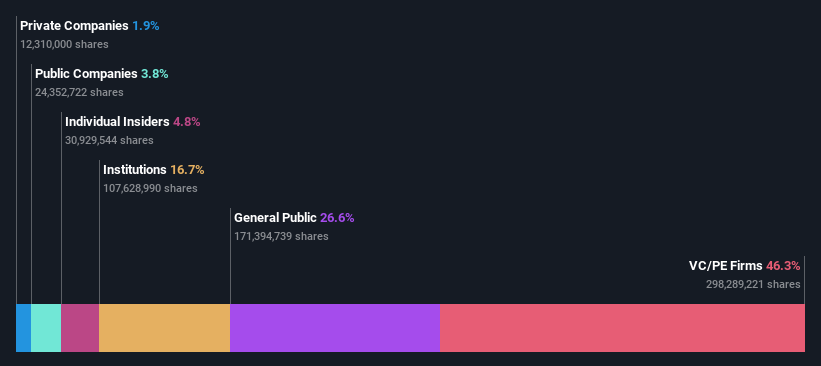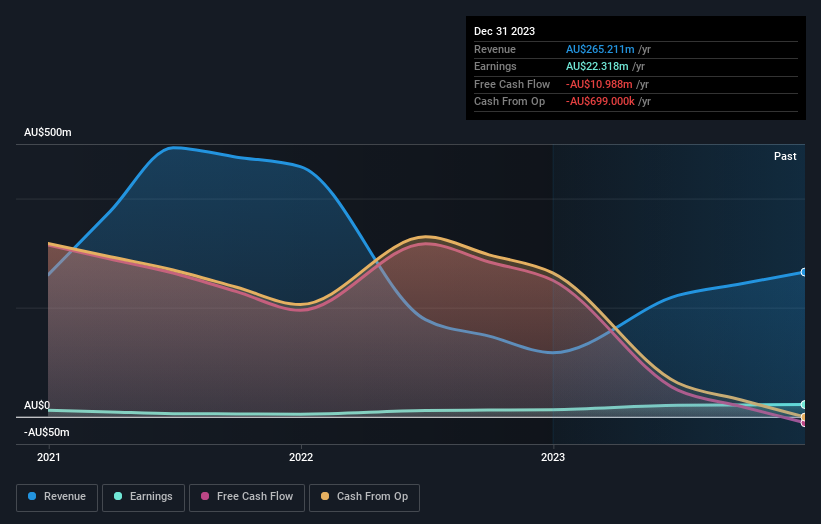Private equity firms account for 46% of ClearView Wealth Limited's (ASX:CVW) ownership, while individual investors account for 27%
Key Insights
Significant control over ClearView Wealth by private equity firms implies that the general public has more power to influence management and governance-related decisions
A total of 2 investors have a majority stake in the company with 62% ownership
A look at the shareholders of ClearView Wealth Limited (ASX:CVW) can tell us which group is most powerful. The group holding the most number of shares in the company, around 46% to be precise, is private equity firms. In other words, the group stands to gain the most (or lose the most) from their investment into the company.
And individual investors on the other hand have a 27% ownership in the company.
Let's take a closer look to see what the different types of shareholders can tell us about ClearView Wealth.
Check out our latest analysis for ClearView Wealth
What Does The Institutional Ownership Tell Us About ClearView Wealth?
Institutional investors commonly compare their own returns to the returns of a commonly followed index. So they generally do consider buying larger companies that are included in the relevant benchmark index.
As you can see, institutional investors have a fair amount of stake in ClearView Wealth. This suggests some credibility amongst professional investors. But we can't rely on that fact alone since institutions make bad investments sometimes, just like everyone does. It is not uncommon to see a big share price drop if two large institutional investors try to sell out of a stock at the same time. So it is worth checking the past earnings trajectory of ClearView Wealth, (below). Of course, keep in mind that there are other factors to consider, too.
ClearView Wealth is not owned by hedge funds. Crescent Capital Partners Management Pty Ltd. is currently the company's largest shareholder with 46% of shares outstanding. For context, the second largest shareholder holds about 16% of the shares outstanding, followed by an ownership of 3.8% by the third-largest shareholder.
After doing some more digging, we found that the top 2 shareholders collectively control more than half of the company's shares, implying that they have considerable power to influence the company's decisions.
Researching institutional ownership is a good way to gauge and filter a stock's expected performance. The same can be achieved by studying analyst sentiments. As far as we can tell there isn't analyst coverage of the company, so it is probably flying under the radar.
Insider Ownership Of ClearView Wealth
The definition of an insider can differ slightly between different countries, but members of the board of directors always count. Management ultimately answers to the board. However, it is not uncommon for managers to be executive board members, especially if they are a founder or the CEO.
I generally consider insider ownership to be a good thing. However, on some occasions it makes it more difficult for other shareholders to hold the board accountable for decisions.
We can report that insiders do own shares in ClearView Wealth Limited. As individuals, the insiders collectively own AU$18m worth of the AU$371m company. This shows at least some alignment. You can click here to see if those insiders have been buying or selling.
General Public Ownership
With a 27% ownership, the general public, mostly comprising of individual investors, have some degree of sway over ClearView Wealth. While this size of ownership may not be enough to sway a policy decision in their favour, they can still make a collective impact on company policies.
Private Equity Ownership
With an ownership of 46%, private equity firms are in a position to play a role in shaping corporate strategy with a focus on value creation. Some investors might be encouraged by this, since private equity are sometimes able to encourage strategies that help the market see the value in the company. Alternatively, those holders might be exiting the investment after taking it public.
Public Company Ownership
Public companies currently own 3.8% of ClearView Wealth stock. We can't be certain but it is quite possible this is a strategic stake. The businesses may be similar, or work together.
Next Steps:
I find it very interesting to look at who exactly owns a company. But to truly gain insight, we need to consider other information, too. Take risks for example - ClearView Wealth has 1 warning sign we think you should be aware of.
Of course this may not be the best stock to buy. Therefore, you may wish to see our free collection of interesting prospects boasting favorable financials.
NB: Figures in this article are calculated using data from the last twelve months, which refer to the 12-month period ending on the last date of the month the financial statement is dated. This may not be consistent with full year annual report figures.
Have feedback on this article? Concerned about the content? Get in touch with us directly. Alternatively, email editorial-team (at) simplywallst.com.
This article by Simply Wall St is general in nature. We provide commentary based on historical data and analyst forecasts only using an unbiased methodology and our articles are not intended to be financial advice. It does not constitute a recommendation to buy or sell any stock, and does not take account of your objectives, or your financial situation. We aim to bring you long-term focused analysis driven by fundamental data. Note that our analysis may not factor in the latest price-sensitive company announcements or qualitative material. Simply Wall St has no position in any stocks mentioned.


